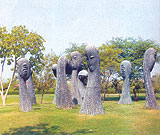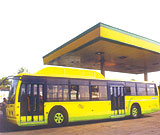|
GOING GREEN
|
|
|
|
The pressure of 16 million people and an exponentially growing mass of 4.5 million vehicles should make Delhi a gas chamber, but instead novel schemes and a slew of initiatives have made the Capital a model city in terms of pollution control and environmental safety
|
The world is trying to combat environmental pollution on a war footing. Manmade threats like CFCs, carbon monoxide from automobile emissions and natural disasters like global warming have made breathing a difficult task.
In the present scenario, it is obvious that the Delhi government is doing its level best in coping with the seemingly antagonistic interests of
development/industrialisation and ecological protection. Today, Delhi is recognised as one of the greenest capital cities in the world. Thanks to the State Government’s efforts, Delhi is becoming a gradually increasingly popular habitat as well as a major tourist
destination in the world. With the approaching 2010 Commonwealth Games in sight, the Delhi Government’s priority seems to focus on countering climatic adversities and achieving a greener and cooler Delhi.
First came compressed natural gas (CNG), rendering Delhi the first city in the world to enforce non-exhaust emitting (thereby non-polluting) commercial vehicles. Then sprang more than 60 flyovers to accommodate the Capital’s four million plus vehicular traffic, reduce congestion and jams. Next, we witnessed the acceleration of the underground metro railway.
|

Sheila Dikshit
Chief Minister, Delhi
Over 1,700,000 trees were planted in 2006, 14 forests are being revived while 9 entirely new city forests are being created. Delhi Metro has promised 10 new trees for every tree felled |

The problems facing authorities in controlling law and order besides pollution in a mega-metropolis of 16 million denizens and 4.5 million automobiles are, naturally, gargantuan.
Air Quality
In this area, Delhi certainly sets an example for the nation. Despite the enormous growth in number of vehicles, air quality in Delhi has registered a marked improvement between 2002 and 2006. The construction of over 60 flyovers and 32 bypasses and underpasses has reduced not just tail pipe emissions due to congestion, jams and stalling in crowded areas but also travel time.
TRANSPORTATION
The Centre for Science and Environment has applauded Delhi’s decision to impose an environment cess on
polluting diesel cars. Simultaneously, sales tax on diesel has been hiked to narrow the price gap between diesel and petrol.
Moreover, while Delhi Transport Corporation (DTC) is now recognised as the world’s largest eco-friendly CNG bus service, and the Delhi Metro project is expected to further reduce 3,94,285 tonnes of carbon dioxide emission between 2007 and 2017 caused by vehicles.
ENERGY CONSERVATION
Replacement of conventional lighting with energy efficient lighting systems, introduction of non-conventional energy, usage for buildings above 500 square metres will reduce Delhi’s dependence on fossil fuels. Almost 300,000 improved
ele ctrical fittings are proposed to be installed over 160 kilometres of city roads. ctrical fittings are proposed to be installed over 160 kilometres of city roads.
WASTE MANAGEMENT
The World Bank has sanctioned a grant to the Municipal Corporation of Delhi for gas recovery and re-use. The step is expected to reduce up to 3 million tonnes equivalent of carbon dioxide. Further plans are afoot to treat and convert 3,500 tonnes of solid waste into 28 MW of power in a 15 acre site.
GREEN BUILDINGS
Increasing greenery is a known method of reducing pollution since plants absorb carbon dioxide in the atmosphere and release oxygen. Over the past 10 years, forest cover in the Capital has increased
fr om 26 square kilometres to more than 300 square kilometres. Finally, novel steps like reducing noise pollution and the Bhagidari Programme. All these initiatives and many more have made Delhi a model city in terms of pollution control and environmental safety. om 26 square kilometres to more than 300 square kilometres. Finally, novel steps like reducing noise pollution and the Bhagidari Programme. All these initiatives and many more have made Delhi a model city in terms of pollution control and environmental safety.
The Delhi Government’s praiseworthy efforts to this end have not only raised living standards and quality of its citizens but also given their morale a shot in the arm. In fact, Delhi’s attempts at reducing pollution—a major cause for concern in today’s world—is bound to set an example to the nation at large sooner than later.
|
|
|
|
|
|
|
|
|
August 2007
|
|


|
|
|
|